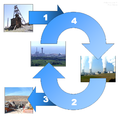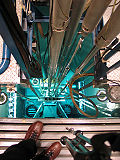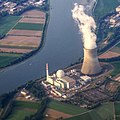Portal:Nuclear technology
The Nuclear Technology Portal
Introduction

- Nuclear technology is technology that involves the nuclear reactions of atomic nuclei. Among the notable nuclear technologies are nuclear reactors, nuclear medicine and nuclear weapons. It is also used, among other things, in smoke detectors and gun sights. (Full article...)
- Nuclear power is the use of nuclear reactions to produce electricity. Nuclear power can be obtained from nuclear fission, nuclear decay and nuclear fusion reactions. Presently, the vast majority of electricity from nuclear power is produced by nuclear fission of uranium and plutonium in nuclear power plants. Nuclear decay processes are used in niche applications such as radioisotope thermoelectric generators in some space probes such as Voyager 2. Reactors producing controlled fusion power have been operated since 1958 but have yet to generate net power and are not expected to be commercially available in the near future. (Full article...)
- A nuclear weapon is an explosive device that derives its destructive force from nuclear reactions, either fission (fission or atomic bomb) or a combination of fission and fusion reactions (thermonuclear weapon), producing a nuclear explosion. Both bomb types release large quantities of energy from relatively small amounts of matter. (Full article...)
General images -
Selected article -
The US–UK Mutual Defense Agreement, or the 1958 UK–US Mutual Defence Agreement, is a bilateral treaty between the United States and the United Kingdom on nuclear weapons co-operation. The treaty's full name is Agreement between the Government of the United States of America and the Government of the United Kingdom of Great Britain and Northern Ireland for Cooperation on the uses of Atomic Energy for Mutual Defense Purposes. It allows the US and the UK to exchange nuclear materials, technology and information. The US has nuclear co-operation agreements with other countries, including France and other NATO countries, but this agreement is by far the most comprehensive. Because of the agreement's strategic value to Britain, Harold Macmillan (the Prime Minister who presided over the United Kingdom's entry into the agreement) called it "the Great Prize".
The treaty was signed on 3 July 1958 after the Soviet Union had shocked the American public with the launch of Sputnik on 4 October 1957, and the British hydrogen bomb programme had successfully tested a thermonuclear device in the Operation Grapple test on 8 November. The special relationship proved mutually beneficial, both militarily and economically. Britain soon became dependent on the United States for its nuclear weapons since it agreed to limit their nuclear program with the agreement of shared technology. The treaty allowed American nuclear weapons to be supplied to Britain through Project E for use by the Royal Air Force and British Army of the Rhine until the early 1990s when the UK became fully independent in designing and manufacturing its own warheads.
The treaty provided for the sale to the UK of one complete nuclear submarine propulsion plant, as well as ten years' supply of enriched uranium to fuel it. Other nuclear material was also acquired from the US under the treaty. Some 5.4 tonnes of UK-produced plutonium was sent to the US in return for 6.7 kilograms (15 lb) of tritium and 7.5 tonnes of highly enriched uranium (HEU) between 1960 and 1979, but much of the HEU was used not for weapons but as fuel for the growing fleet of British nuclear submarines. The treaty paved the way for the Polaris Sales Agreement, and the Royal Navy ultimately acquired entire weapons systems, with the UK Polaris programme and Trident nuclear programme using American missiles with British nuclear warheads.
The treaty has been amended and renewed ten times. On 14 November 2024, it was extended indefinitely. (Full article...)
Selected picture -
Did you know?
- ... that some years after unknowingly working for the Manhattan Project, Charles Fisk quit physics and became an organ builder?
- ... that the Russian and Belarussian military exercise Zapad 2009 involved nuclear-capable ballistic missiles?
- ... that 1ES 1927+654, a galaxy in Draco, exhibited such extreme nuclear activity that it challenged conventional models of black-hole environments?
- ... that T. K. Jones thought that a nuclear war was survivable if "there are enough shovels to go around"?
- ... that Jeya Wilson invited New Zealand prime minister David Lange to debate the moral indefensibility of nuclear weapons at the Oxford Union?
- ... that poet Peggy Pond Church became a strong pacifist and a member of the Society of Friends after the Manhattan Project used her home as a place to build nuclear weapons?
Related WikiProjects
Things you can do
| Parts of this portal (those related to section) need to be updated. Please help update this portal to reflect recent events or newly available information. Relevant discussion may be found on the talk page. (September 2021) |
|
Here are some Open Tasks :
|
Selected biography -
During World War I, he served in the U.S. Army, where he worked on the development of poison gases, especially lewisite. He became an assistant professor of chemistry at Harvard University in 1919 and the Sheldon Emery Professor of Organic Chemistry in 1929. He researched the physical structures of natural products, particularly chlorophyll, and he was one of the first to explore the sometimes complex relationship between chemical equilibrium and the reaction rate of chemical processes. He studied the biochemistry of oxyhemoglobin providing insight into the disease methemoglobinemia, helped to explain the structure of chlorophyll, and contributed important insights that underlie modern theories of acid-base chemistry.
In 1933, Conant became the president of Harvard University with a reformist agenda that included dispensing with a number of customs, including class rankings and the requirement for Latin classes. He abolished athletic scholarships, and instituted an "up or out" policy, under which untenured faculty who were not promoted were terminated. His egalitarian vision of education required a diversified student body, and he promoted the adoption of the Scholastic Aptitude Test (SAT) and co-educational classes. During his presidency, women were admitted to Harvard Medical School and Harvard Law School for the first time.
Conant was appointed to the National Defense Research Committee (NDRC) in 1940, becoming its chairman in 1941. In this capacity, he oversaw vital wartime research projects, including the development of synthetic rubber and the Manhattan Project, which developed the first atomic bombs. On July 16, 1945, he was among the dignitaries present at the Alamogordo Bombing and Gunnery Range for the Trinity nuclear test, the first detonation of an atomic bomb, and was part of the Interim Committee that advised President Harry S. Truman to use atomic bombs on Japan. After the war, he served on the Joint Research and Development Board (JRDC) that was established to coordinate burgeoning defense research, and on the influential General Advisory Committee (GAC) of the Atomic Energy Commission (AEC); in the latter capacity he advised the president against starting a development program for the hydrogen bomb.
In his later years at Harvard, Conant taught undergraduate courses on the history and philosophy of science, and wrote books explaining the scientific method to laymen. In 1953, he retired as president of Harvard University and became the United States High Commissioner for Germany, overseeing the restoration of German sovereignty after World War II, and then was Ambassador to West Germany until 1957.
On returning to the United States, Conant criticized the education system in The American High School Today (1959), Slums and Suburbs (1961), and The Education of American Teachers (1963). Between 1965 and 1969, Conant authored his autobiography, My Several Lives (1970). He became increasingly infirm, had a series of strokes in 1977, and died in a nursing home in Hanover, New Hampshire, the following year. (Full article...)
Nuclear technology news
- 2 July 2025 –
- Iranian president Masoud Pezeshkian orders the suspension of cooperation with the International Atomic Energy Agency following the Iran–Israel war and the United States strikes on Iranian nuclear sites. (AP)
- 25 June 2025 – Middle Eastern crisis
- United States strikes on Iranian nuclear sites
- A preliminary assessment by the U.S. Defense Intelligence Agency finds that Iran's nuclear program may have only been set back by a few months after the U.S. airstrikes, with the centrifuges required to enrich uranium left largely intact, contradicting previous claims made by U.S. president Donald Trump that the facilities were "obliterated". (AP)
- After U.S. president Donald Trump rejects the DIA assessment as "fake news", U.S. Central Intelligence Agency director John Ratcliffe says that the CIA assesses that several key Iranian nuclear facilities were severely damaged in the airstrikes, likely requiring years to rebuild. (BBC News)
Related portals
Related topics
Subcategories
Associated Wikimedia
The following Wikimedia Foundation sister projects provide more on this subject:
-
Commons
Free media repository -
Wikibooks
Free textbooks and manuals -
Wikidata
Free knowledge base -
Wikinews
Free-content news -
Wikiquote
Collection of quotations -
Wikisource
Free-content library -
Wikiversity
Free learning tools -
Wiktionary
Dictionary and thesaurus



































































































